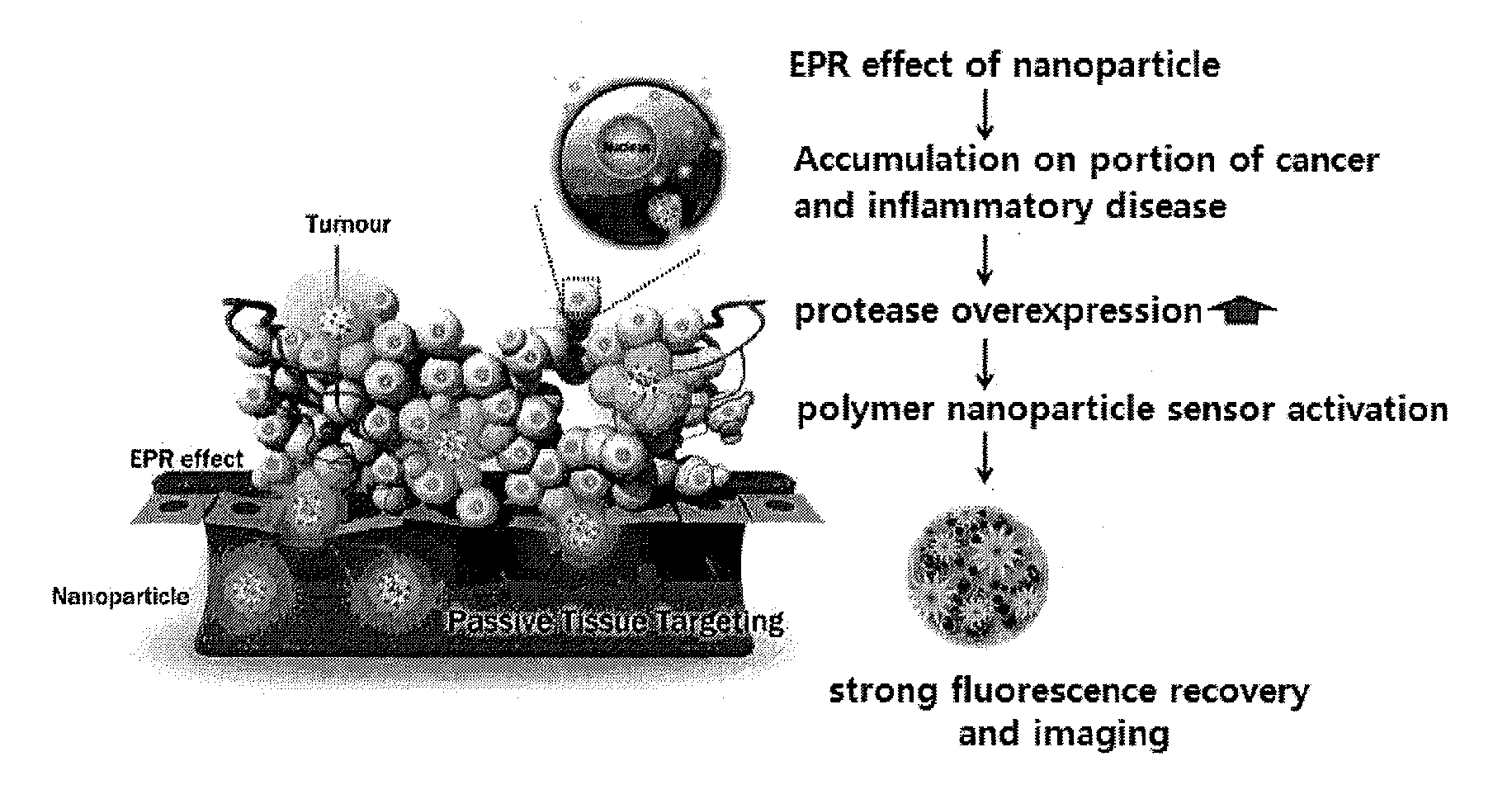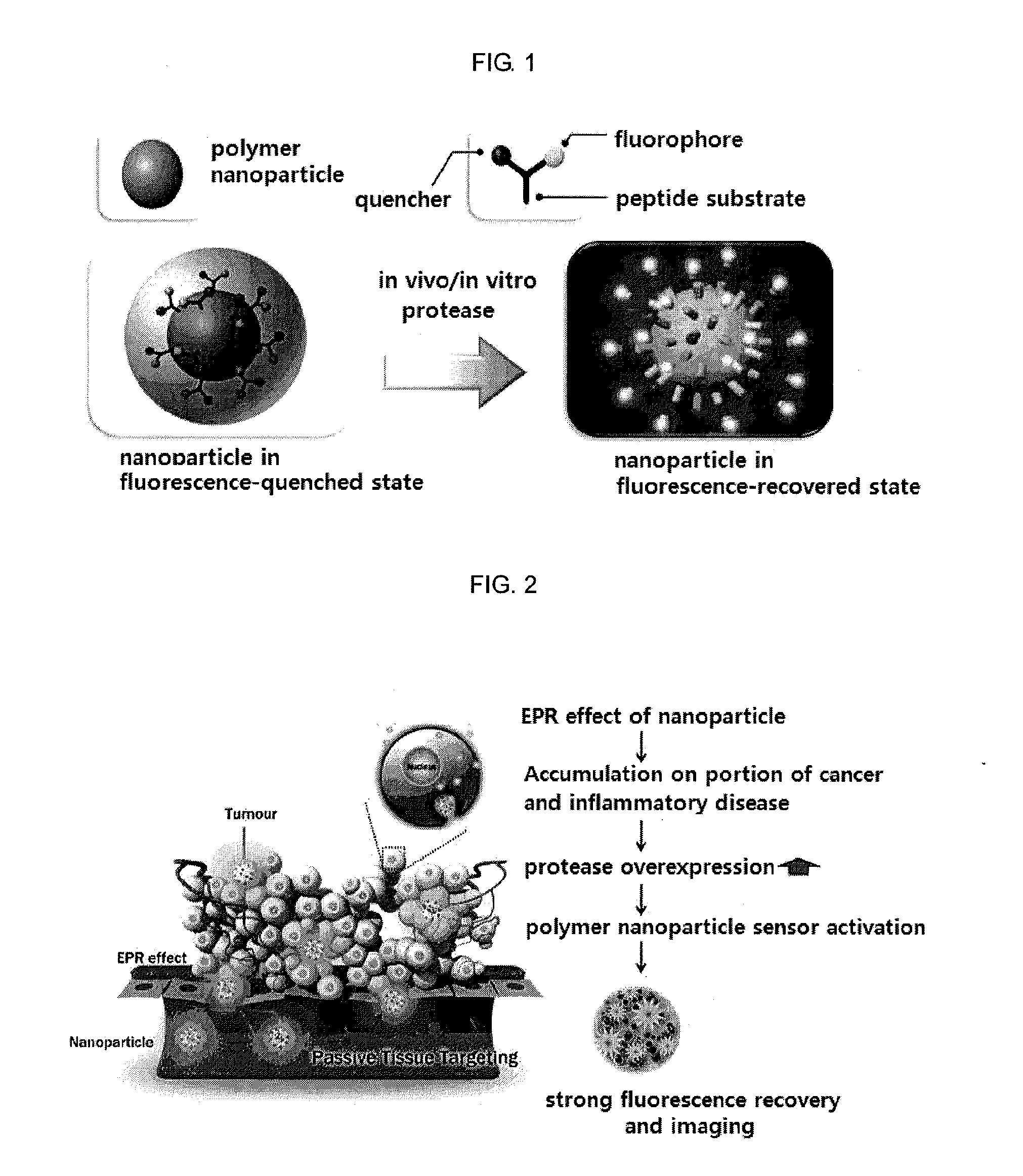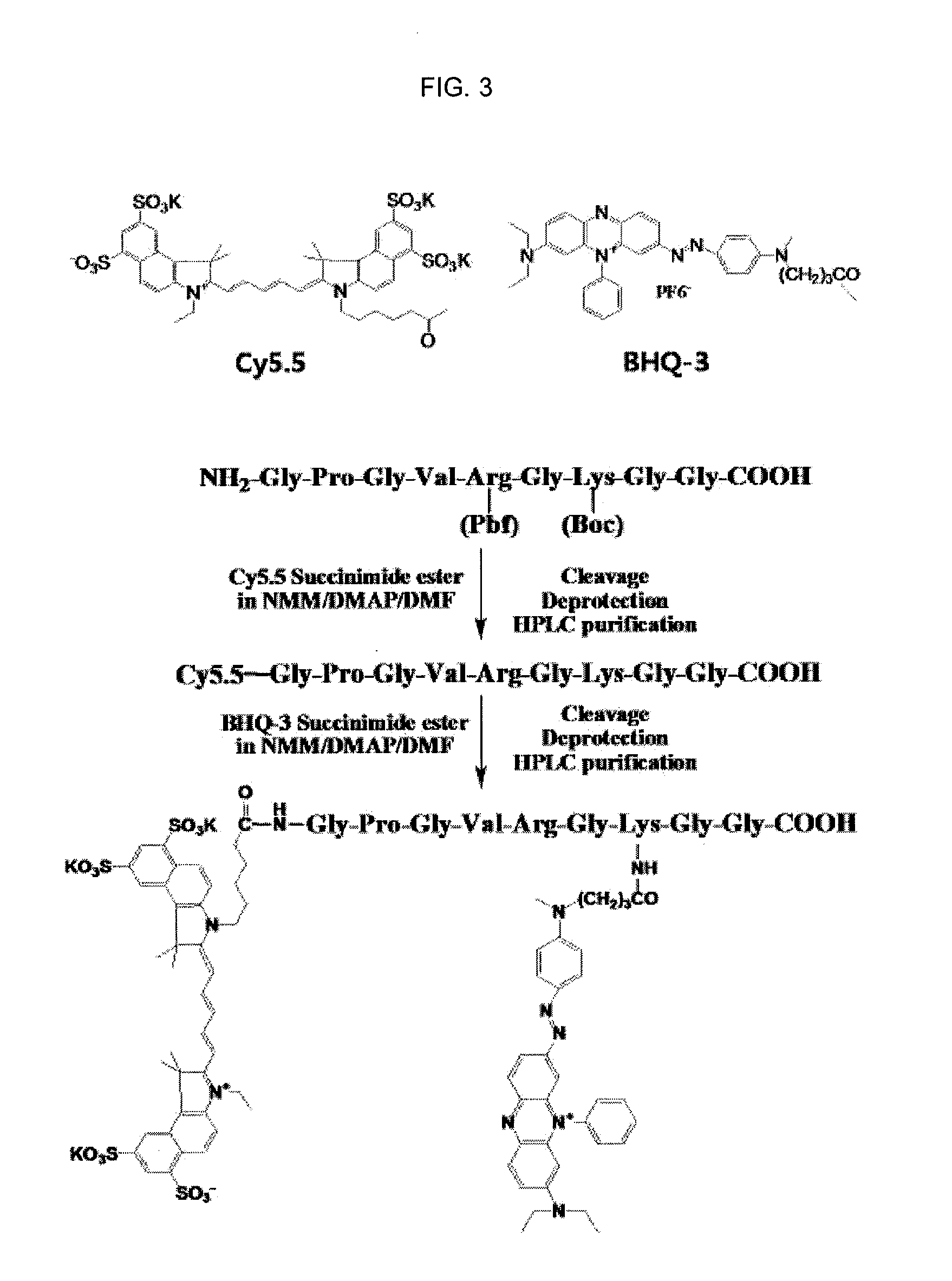Nanoparticle sensor for measuring protease activity and method for manufacturing the same
a technology of protease activity and nanoparticles, applied in the direction of instruments, peptides/protein ingredients, peptides, etc., can solve the problems of insufficient introduction of quantitatively imaging and analyzing the activity and expression of specific proteases or non-invasively imaging the expression level of proteases in vivo, and the development of related techniques is urgently needed. , to achieve the effect of inhibiting fluorescence emission and high extinctive activity
- Summary
- Abstract
- Description
- Claims
- Application Information
AI Technical Summary
Benefits of technology
Problems solved by technology
Method used
Image
Examples
example 1
Preparation of Fluorophore-Peptide-Quencher-Nanoparticle Derivative
[0078]1-1. Preparation of Fluorophore-Peptide-Quenching Derivative
[0079]First, to prepare a fluorophore- and quencher-conjugated peptide, the peptide was prepared by Fmoc strategy according to a solid phase synthesis, and the fluorophore and the quencher were chemically conjugated to the prepared peptide sequence.
[0080]As the fluorophores, Cy5.5 (ex / em, 670 / 690), TRITC (ex / em, 547 / 572) and FITC (ex / em, 490 / 520) were used. As the quenchers for quenching fluorescence emitted from each of Cy5.5, TRITC and FITC fluorophores, BHQ-3 (abs. 620 nm-730 nm), BHQ-2 (abs. 550 nm-650 nm) and BHQ-1 (abs. 480 nm-580 nm) (Biosearch Technologies Inc.) were used, respectively.
[0081]As one example, a process of synthesizing a fluorophore-peptide-quencher, which emitted fluorescence by being selectively lysed by MMP-2, was as follows (see FIG. 3).
[0082]NH2-Gly-Pro-Leu-Gly-Val-Arg(Pbf)-Gly-Lys(Boc)-Gly-Gly-COON as a peptide substrate, se...
experimental example 1
Variation of Optical Properties of Protease Sensor by MMP-Specific Lysing
[0094]Specific selectivities for proteases of the polymer based sensors, which was prepared in Example 1 and specific to MMPs, were observed. Each of the sensors (PN1, PN2 and PN3) was added in a mixture containing proteases, thereby measuring fluorescent intensities (FIs) recovered according to time.
[0095]In detail, PN1, PN2 and PN3 (10 μg / Ml each), which specifically reacted with MMPs to recover fluorescence, were added in MMP-2, MMP-3, MMP-7, MMP-9 or MMP-13 (1 μg / Ml) all in an active state, and emission of fluorescence by zymolysis was observed. For activating each MMP, the MMPs were added in TCNB solution (0.1 M of Tris, 5 mM of calcium chloride, 200 mM of NaCl and 0.1% of brij), in which p-aminophenyl mercuric acid were mixed, followed by reaction at 37° C. for 1 hour. The activated MMPs respectively reacted with a polymer nanoparticle based sensor in 200 μl of solution in a 96-well at 37° C., thereby obs...
example 2
Fluorescence Recovery and Imaging of Protease Activity Measuring Sensor According to Concentration of Protease
[0099]The sensors prepared in Example 1 were used to quantitatively analyze concentrations of proteases. In detail, according to the same method as in Example 1, activated MMP-2s respectively in concentrations of 0, 0.55, 1, 3, 7 and 14 nmol / L were added in the PN1 sensor and reacted with each other at 37° C. for 60 minutes, thereby observing emission levels of fluorescence (fluorescent intensities) using a fluorescence spectrometer and a digital imaging system (Kodak Image Station 4000 mM).
[0100]As shown in FIG. 5A, fluorescence emitted from the PN1 sensor was increased in proportion to the concentration of the added MMP-2 protease. It was thusly proved that a specific protease concentration within a specimen could be quantitatively detected by measuring the fluorescence intensity of an experimental group, and imaging thereof could be carried out using an optical imaging sy...
PUM
| Property | Measurement | Unit |
|---|---|---|
| wavelengths | aaaaa | aaaaa |
| wavelengths | aaaaa | aaaaa |
| wavelengths | aaaaa | aaaaa |
Abstract
Description
Claims
Application Information
 Login to View More
Login to View More - R&D
- Intellectual Property
- Life Sciences
- Materials
- Tech Scout
- Unparalleled Data Quality
- Higher Quality Content
- 60% Fewer Hallucinations
Browse by: Latest US Patents, China's latest patents, Technical Efficacy Thesaurus, Application Domain, Technology Topic, Popular Technical Reports.
© 2025 PatSnap. All rights reserved.Legal|Privacy policy|Modern Slavery Act Transparency Statement|Sitemap|About US| Contact US: help@patsnap.com



